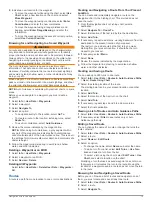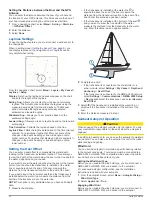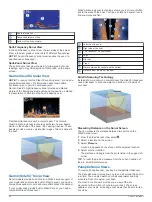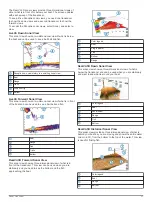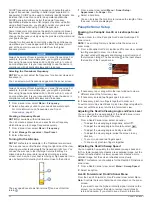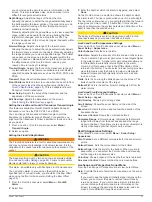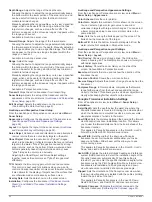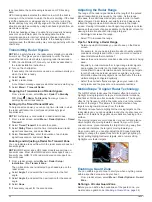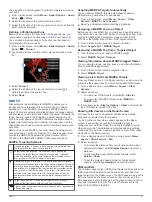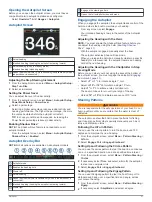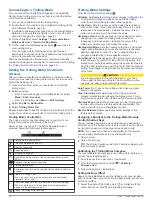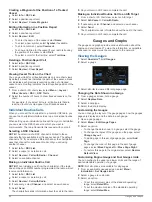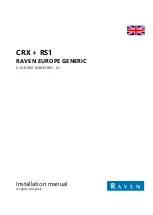
together. If the value is too low , the targets are small and
more difficult to see.
You can use echo stretch and filter width together to obtain
the preferable resolution and noise reduction. With echo
stretch and filter width set to low, the display has the highest
resolution, but is the most susceptible to noise. With echo
stretch set to high and filter width set to low, the display has a
lower resolution, but has wider targets. With echo stretch and
filter width set to high, the display has the lowest resolution,
but is the least susceptible to noise. It is not recommended to
set echo stretch to low and filter width to high.
Overlay Data
: Sets the data shown on the sonar screen.
Sonar Alarms
WARNING
The sonar alarms feature is a tool for situational awareness only
and may not prevent grounding in all circumstances. It is your
obligation to ensure safe operation of the vessel.
The shallow water alarm feature is a tool for situational
awareness only and may not prevent groundings in all
circumstances. It is your obligation to ensure safe operation of
the vessel.
CAUTION
The Beeper setting must be turned on to make alarms audible
(
). Failure to set audible
alarms could lead to injury or property damage.
NOTE:
Not all options are available on all transducers.
From an applicable sonar view, select
Menu
>
Sonar Setup
>
Alarms
.
You can also open the sonar alarms by selecting
Settings
>
Alarms
>
Sonar
.
Shallow Water
: Sets an alarm to sound when the depth is less
than the specified value.
Deep Water
: Sets an alarm to sound when the depth is greater
than the specified value.
FrontVü Alarm
: Sets an alarm to sound when the depth in front
of the vessel is less than the specified value, which can help
you avoid running aground (
Setting the FrontVü Depth Alarm
). This alarm is available only with Panoptix FrontVü
transducers.
Water Temp.
: Sets an alarm to sound when the transducer
reports a temperature that is 2°F (1.1°C) above or below the
specified temperature.
Contour
: Sets an alarm to sound when the transducer detects a
suspended target within the specified depth from the surface
of the water and from the bottom.
Fish
Fish
: Sets an alarm to sound when the device detects a
suspended target.
•
sets the alarm to sound when fish of all sizes are
detected.
•
sets the alarm to sound only when medium or large
fish are detected.
•
sets the alarm to sound only when large fish are
detected.
Advanced Sonar Settings
From a Traditional sonar view, select
Menu
>
Sonar Setup
>
Advanced
.
Shift
: Allows you to set the depth range on which the sonar is
focused. This allows you to zoom in a higher resolution in the
focused depth.
When using shift, bottom tracking may not work effectively,
because the sonar looks for data within the depth range of
the focused area, which may not include the bottom. Using
shift also can impact the scroll speed, because data outside
the depth range of the focused area is not processed, which
reduces the time required to receive and display the data.
You can zoom in to the focused area, which enables you to
evaluate target returns more closely at a higher resolution
than just zooming alone.
Btm. Srch. Limit
: Limits the search for the bottom to the depth
selected when the Range setting is set to Auto. To minimize
the length of time it takes to find the bottom, you can select a
depth to limit the search for the bottom. The device will not
search for the bottom deeper than the selected depth.
Traditional, Garmin ClearVü, and SideVü Transducer
Installation Settings
From a Traditional, Garmin ClearVü, or SideVü sonar view,
select
Menu
>
Sonar Setup
>
Installation
.
Transmit Rate
: Sets the length of time between sonar pings.
Increasing the transmit rate increases the scroll speed, but it
may also increase self-interference.
Reducing the transmit rate increases the spacing between
transmit pulses and can resolve self-interference. This option
is available on the Traditional sonar view only.
Transmit Power
: Reduces transducer ringing near the surface.
A lower transmit power value reduces transducer ringing, but
can also reduce the strength of the returns. This option is
available on the Traditional sonar view only.
Filter Width
: Defines the edges of the target. A shorter filter
more clearly defines the edges of the targets but may allow
more noise. A longer filter creates softer target edges and
may also reduce noise. This option is available on the
Traditional sonar view only.
Flip Left/Right
: Switches the SideVü view orientation from left
to right. This option is available on the SideVü sonar view
only.
Restore Sonar Defaults
: Restores the sonar settings to the
factory default values.
Allows you to change the transducer, view details about the
transducers, and save details to a memory card.
Sonar Frequencies
NOTE:
The frequencies available depend on the device and
trandsucers being used.
Adjusting the frequency helps adapt the sonar for your particular
goals and the present depth of the water.
Higher frequencies use narrow beam widths, and are better for
high-speed operation and rough sea conditions. Bottom
definition and thermocline definition can be better when using a
higher frequency.
Lower frequencies use wider beam widths, which can let the
fisherman see more targets, but could also generate more
surface noise and reduce bottom signal continuity during rough
sea conditions. Wider beam widths generate larger arches for
fish target returns, making them ideal for locating fish. Wider
beam widths also perform better in deep water, because the
lower frequency has better deep water penetration.
Sonar Fishfinder
31



